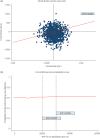Cost-utility analysis of Social Stories™ for children with autism spectrum disorder in mainstream primary schools: results from a randomised controlled trial
- PMID: 38826027
- PMCID: PMC11363088
- DOI: 10.1192/bjo.2024.47
Cost-utility analysis of Social Stories™ for children with autism spectrum disorder in mainstream primary schools: results from a randomised controlled trial
Abstract
Background: One in 57 children are diagnosed with autism in the UK, and the estimated cost for supporting these children in education is substantial. Social Stories™ is a promising and widely used intervention for supporting children with autism in schools and families. It is believed that Social Stories™ can provide meaningful social information to children that can improve social understanding and may reduce anxiety. However, no economic evaluation of Social Stories has been conducted.
Aims: To assess the cost-effectiveness of Social Stories through Autism Spectrum Social Stories in Schools Trial 2, a multi-site, pragmatic, cluster-randomised controlled trial.
Method: Children with autism who were aged 4-11 years were recruited and randomised (N = 249). Costs measured from the societal perspective and quality-adjusted life-years (QALYs) measured by the EQ-5D-Y-3L proxy were collected at baseline and at 6-month follow-up for primary analysis. The incremental cost-effectiveness ratio was calculated, and the uncertainty around incremental cost-effectiveness ratios was captured by non-parametric bootstrapping. Sensitivity analyses were performed to evaluate the robustness of the primary findings.
Results: Social Stories is likely to result in a small cost savings (-£191 per child, 95% CI -767.7 to 337.7) and maintain similar QALY improvements compared with usual care. The probability of Social Stories being a preferred option is 75% if society is willing to pay £20 000 per QALY gained. The sensitivity analysis results aligned with the main study outcomes.
Conclusions: Compared with usual care, Social Stories did not lead to an increase in costs and maintained similar QALY improvements for primary-aged children with autism.
Keywords: Autism spectrum disorders; Social Stories; child and adolescent; cost-effectiveness; quality-adjusted life-years.
Conflict of interest statement
B.W. is a Trustee of Biomation CEC and co-author of
Figures


References
-
- American Psychiatric Association. Diagnostic and Statistical Manual of Mental Disorders (5th ed). American Psychiatric Publishing, 2013.
-
- Buescher AVS, Cidav Z, Knapp M, Mandell DS. Costs of autism spectrum disorders in the United Kingdom and the United States. JAMA Pediatr 2014; 168(8): 721–8. - PubMed
-
- Lindsay S, Proulx M, Thomson N, Scott H. Educators’ challenges of including children with autism Spectrum disorder in mainstream classrooms. Int J Disabil Dev Educ 2013; 60(4): 347–62.
LinkOut - more resources
Full Text Sources

